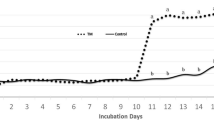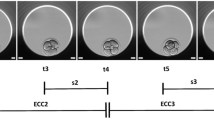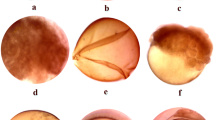Abstract
High ambient temperatures are a determining factor in the deterioration of embryo quality and survival in mammals. The aim of this study was to evaluate the effect of heat stress on embryo development, embryonic size and size of the embryonic coats in rabbits. A total of 310 embryos from 33 females in thermal comfort zone and 264 embryos of 28 females in heat stress conditions were used in the experiment. The traits studied were ovulation rate, percentage of total embryos, percentage of normal embryos, embryo area, zona pellucida thickness and mucin coat thickness. Traits were measured at 24 and 48 h post-coitum (hpc); mucin coat thickness was only measured at 48 hpc. The embryos were classified as zygotes or two-cell embryos at 24 hpc, and 16-cells or early morulae at 48 hpc. The ovulation rate was one oocyte lower in heat stress conditions than in thermal comfort. Percentage of normal embryos was lower in heat stress conditions at 24 hpc (17.2%) and 48 hpc (13.2%). No differences in percentage of zygotes or two-cell embryos were found at 24 hpc. The embryo development and area was affected by heat stress at 48 hpc (10% higher percentage of 16-cells and 883 μm2 smaller, respectively). Zona pellucida was thicker under thermal stress at 24 hpc (1.2 μm) and 48 hpc (1.5 μm). No differences in mucin coat thickness were found. In conclusion, heat stress appears to alter embryology in rabbits.
Similar content being viewed by others
References
Alliston CW, Howarth B, Ulberg LC (1965) Embryonic mortality following culture in vitro of one- and two-cell rabbit eggs at elevated temperatures. J Reprod Fertil 9:337–341
Anderson LH, Christenson LK, Christenson RK, Ford SP (1993) Investigation into the control of litter size in swine: II. Comparisons of morphological and functional embryonic diversity between Chinese and American breeds. J Anim Sci 71:1566–1571
Argente MJ, García ML, Muelas R, Blasco A (2014) Effect of selection for residual variance of litter size on components of litter size in rabbits. In: Proceedings of the 10th World Congress on Genetics Applied to Livestock Production, Vancouver, Canada paper n.149
Argente MJ, Merchán M, Peiró R, García ML, Santacreu MA, Folch JM, Blasco A (2010) Candidate gene analysis for reproductive traits in two lines of rabbits divergently selected for uterine capacity. J Anim Sci 88:828–836
Besenfelder U, Haas C, Brem G (2000) Reproduction technology and gene transfer in rabbits. In: Proceedings 7th world rabbit congress, Valencia Spain, p 37–59
Bourdage RJ, Halbert SA (1988) Distribution of embryos and 500-μm microspheres in the rabbit oviduct: controls for acute motion analysis during transport. Biol Reprod 38:282–291
Bridges PJ, Brusie MA, Fortune JE (2005) Elevated temperature (heat stress) in vitro reduces androstenedione and estradiol and increases progesterone secretion by follicular cells from bovine dominant follicles. Domes Anim Endocrinol 29:508–522
Burfening PJ, Ulberg LC (1968) Embryonic survival subsequent to culture of rabbit spermatozoa at 38°C and 40°C. J Reprod Fertil 15:87–92
Dean J (1992) Biology of mammalian fertilization: the role of the zona pellucida. J Clin Inves 89:1055–1059
Dutt RH (1963) Critical period for early embryo mortality in ewes exposed to high ambient temperature. J Anim Sci 22(3):713–719
Edwards RL, Omtvedt IT, Tuesman EJ, Stephens DF, Mahoney GWA (1968) Reproductive performance of gilts following heat stress prior to breading and early gestation. J Anim Sci 6:1634–1637
Fair T (2010) Mammalian oocyte development checkpoints for competence. Reprod. Fertil Dev 22:13–20
FAOSTAT 2016 http://faostat.fao.org/. Accessed 20 August 2016
Ferreira R, Ayres H, Chiaratti M, Ferraz ML, Araújo AB, Rodrigues CA, Watanabe YF, Vireque AA, Joaquim DC, Smith LC, Meirelles FV, Baruselli PS (2011) The low fertility of repeat breeder cows during summer heat stress is related to a low oocyte competence to develop into blastocysts. J Dairy Sci 94:2383–2392
Fischer B, Mootz U, Denker HW, Lambertz M, Beier M (1991) The dynamic structure of rabbit blastocyst coverings. III. Transformation of coverings under non-physiological developmental conditions. Anat Embryol 183:17–27
Fujimoto S, Rawson JMR, Dukelow WR (1974) Hormonal influences on the time of ovulation in the rabbit as determined by laparoscopy. J. Reprod Fertil 38:97–103
Garcia ML, Lavara R, Viudes de Castro MP, Vicente JS (2000). Litter size components from two selected lines of rabbits. In: Proceedings 7th world rabbit congress, Valencia Spain, p 133–137
Hansen PJ (2009) Effects of heat stress on mammalian reproduction. Phil Trans R Soc B 364:3341–3350
Hansen PJ, Drost M, Rivera RM, Paula-Lopes FF, Al-Katanani YM, Krininger CC, Chase CC (2001) Adverse impact of heat stress on embryo production: causes and strategies for mitigation. Theriogenology 55:91–103
Hansen J, Sato M (2016) Regional climate change and national responsibilities. Environm Res Lett. doi:10.1088/1748-9326/11/3/034009
Herrler A, Beier HM (2000) Early embryonic coats: morphology, function, practical apllications. Cells Tissues Organs 166:233–246
Honig H, Ofer L, Kaim M, Jacobi S, Shinder D, Gershon E (2016) Effect of cooling management on blood flow to the dominant follicle and estrous cycle length at heat stress. Theriogenology 86(2):626–634
Hunter MG, Robinson RS, Mann GE, Webb R (2004) Endocrine and paracrine control of follicular development and ovulation rate in farm species. Anim Reprod Sci 82-83:461–477
Kim WK, Mirkes PE (2003) Alterations in mitochondrial morphology are associates with hyperthermia-induced apoptosis in early post implantation mouse embryos. Birth Defects Res A Clin Mol Teratol 67:929–940
Leiser R, Denker HW (1988) The dynamic structure of rabbit blastocyst coverings. II ultrastructural evidence for a role of the trophoblast in neozone formation. Anat Embryol (Berl) 179:129–134
Liu DY, Baker HWG (2000) Defective sperm-zona pellucida interaction: a major cause of failure of fertilization in clinical in vitro fertilization. Hum Reprod 15:702–708
MacCracken MC (2008) Prospects for future climate change and the reasons for early action. J Air Waste Manage Assoc 58:735–786
Marai IFM, Ayyat MS, Abd El-Monem UM (2001) Growth performance and reproductive traits at first parity of New Zealand white female rabbits as affected by heat stress and its alleviation under Egyptian conditions. J Trop Anim Health Prod 33:1–12
Marai IFM, Habeeb AAM, Gad AE (2002) Rabbits’ productive, reproductive and physiological performance traits as affected by heat stress: a review. Livest Prod Sci 78:71–90
Marai IFM, Rashwan AA (2004) Rabbits behavioural response to climatic and managerial conditions. A review. Arch Tierz Dummerstof 47(5):469–482
Matsuzuka T, Ozawa M, Nakamura A, Ushitani A, Hirabayashi M, Kanai Y (2005) Effects of heat stress on the redox status in the oviduct and early embryonic development in mice. J Reprod Dev 51:281–287
Maurer RR (1978) Advances in rabbit embryo culture. In: Daniel JC (ed) Methods in mammalian reproduction. Academic Press, New York, pp 259–272
Maya-Soriano MJ, Taberner E, Sabés-Alsina M, Ramon J, Rafel O, Tusell L, Piles M, López-Bejar M (2015) Daily exposure to summer temperatures affects the motile subpopulation structure of epididymal sperm cells but not male fertility in an in vivo rabbit model. Theriogenology 84:384–389
Murakami H, Imai H (1996) Successful implantation of in vitro cultured rabbit embryos after uterine transfer: a role for mucin. Mol Reprod Dev 43:167–170
Nawroth F, Müller P, Wolf C, Sudik R (2000) Is the zona pellucida thickness of metaphase-II oocytes in an IVF/ICSI program influenced by the patient’s age? Gynecol Obstet Inves 52:55–59
Okabe M (2014) Mechanism of fertilization: a modern view. Exp Anim 63(4):357–365
Oseni SO (2012) Rabbit production in low-input systems in Africa prospects, challenges and opportunities. In: Proceedings 10th world rabbit congress. Sharm El-Sheikh, Egypt, p 719–731
Peiró R, Merchán M, Santacreu MA, Argente MJ, García ML, Folch JM, Blasco A (2008) Identification of single-nucleotide polymorphism in the progesterone receptor gene and its association with reproductive traits in rabbits. Genetics 180:1699–1705
Quesnel H, Boulot S, Le Cozler Y (2005) Seasonal variation of reproductive performance of the sow. INRA Prod Anim 18:101–110
Samkol P, LuKefahr SD (2008) A challenging role for organic rabbit production towards poverty alleviation n south East Asia. In: Proceedings of 9th World rabbit Congress. Verona, Italy, p 1479–1499
Sun YP, Xu Y, Cao T, Su YC, Guo YH (2005) Zona pellucida thickness and clinical pregnancy outcome following in vitro fertilization. Int J Gynecol Obstet 89:258–262
Teague HS, Roller WL, Grifo AP (1968) Influence of high temperature and humidity on the reproductive performance in swine. J Anim Sci 27:408–411
Woody CO, Ulberg LC (1964) Viability of one-cell sheep ova as affected by high environmental temperature. J Reprod Fertil 7:275–280
Yan Y, Li S, Zhang P (2012) Transforming the backyard farming unit to the industrial production unit: The “Kangda model”. In: Proceedings of 10th World rabbit Congress. Sharm El-Sheikh, Egypt, p 767–770
Yassein SA, Mahmoud KGM, Maghraby N, Ezzo OH (2008) Hot climate effects and their amelioration on some productive and reproductive traits in rabbit does. World Rabbit Sci 16:173–181
Zheng LL, Tan XW, Cui XZ, Yuan HJ, Jiao GZ, Ji CL, Tan JH (2016) Preimplantation maternal stress impairs embryos development by inducing oviductal apoptosis with activation od the FAS system. Mol Hum Reprod 22(11):778–790
Acknowledgements
This experiment was supported by the National Research Plan projects AGL2011-29831-C03-02 and GVPRE/2008/145.
Author information
Authors and Affiliations
Corresponding author
Rights and permissions
About this article
Cite this article
García, M.L., Argente, M.J. Exposure to high ambient temperatures alters embryology in rabbits. Int J Biometeorol 61, 1555–1560 (2017). https://doi.org/10.1007/s00484-017-1334-0
Received:
Revised:
Accepted:
Published:
Issue Date:
DOI: https://doi.org/10.1007/s00484-017-1334-0




